


A tunnel boring machine (TBM), also known as a "mole", is a machine used to excavate tunnels. Tunnels are excavated through hard rock, wet or dry soil, or sand. TBMs have been customized to work with each material. TBM-bored tunnel cross-sections range from one metre (3.3 ft) (micro-TBMs) to 17.6 metres (58 ft) to date. Narrower tunnels are typically bored using trenchless construction methods or horizontal directional drilling rather than TBMs. TBM tunnels are typically circular in cross-section although they can be customized for u-shaped, horseshoe, square or rectangular tunnels.
Tunnel boring machines are an alternative to drilling and blasting (D&B) methods and "hand mining". TBMs may be used for microtunneling.
TBMs limit the disturbance to the surrounding ground and produce a smooth tunnel wall. This reduces the cost of lining the tunnel, and is suitable for use in urban areas. TBMs are expensive to construct, and larger ones are difficult to transport. These up-front costs become less significant for longer tunnels. Tunneling with TBMs is much more efficient and shortens completion times. TBMs are not used for tunnels in heavily fractured and sheared rock.
History

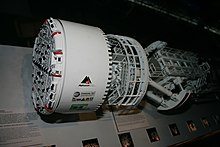
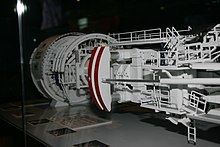
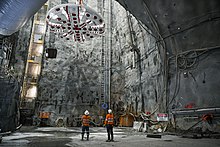
The first successful tunnelling shield was developed by Sir Marc Isambard Brunel to excavate the Thames Tunnel in 1825. However, this was only the invention of the shield concept and did not involve the construction of a complete tunnel boring machine, the digging still having to be accomplished by the then standard excavation methods.
The first boring machine reported to have been built was Henri Maus's Mountain Slicer. Commissioned by the King of Sardinia in 1845 to dig the Fréjus Rail Tunnel between France and Italy through the Alps, Maus had it built in 1846 in an arms factory near Turin. It consisted of more than 100 percussion drills mounted in the front of a locomotive-sized machine, mechanically power-driven from the entrance of the tunnel. The Revolutions of 1848 affected the funding, and the tunnel was not completed until 10 years later, by using less innovative and less expensive methods such as pneumatic drills.
In the United States, the first boring machine to have been built was used in 1853 during the construction of the Hoosac Tunnel in northwest Massachusetts. Made of cast iron, it was known as Wilson's Patented Stone-Cutting Machine, after inventor Charles Wilson. It drilled 10 feet (3 m) into the rock before breaking down. (The tunnel was eventually completed more than 20 years later, and as with the Fréjus Rail Tunnel, by using less ambitious methods.) Wilson's machine anticipated modern TBMs in the sense that it employed cutting discs, like those of a disc harrow, which were attached to the rotating head of the machine. In contrast to traditional chiseling or drilling and blasting, this innovative method of removing rock relied on simple metal wheels to apply a transient high pressure that fractured the rock.
In 1853, the American Ebenezer Talbot also patented a TBM that employed Wilson's cutting discs, although they were mounted on rotating arms, which in turn were mounted on a rotating plate. In the 1870s, John D. Brunton of England built a machine employing cutting discs that were mounted eccentrically on rotating plates, which in turn were mounted eccentrically on a rotating plate, so that the cutting discs would travel over almost all of the rock face that was to be removed.
The first TBM that tunneled a substantial distance was invented in 1863 and improved in 1875 by British Army officer Major Frederick Edward Blackett Beaumont (1833–1895); Beaumont's machine was further improved in 1880 by British Army officer Major Thomas English (1843–1935). In 1875, the French National Assembly approved the construction of a tunnel under the English Channel and the British Parliament supported a trial run using English's TBM. Its cutting head consisted of a conical drill bit behind which were a pair of opposing arms on which were mounted cutting discs. From June 1882 to March 1883, the machine tunneled, through chalk, a total of 1,840 m (6,036 ft). A French engineer, Alexandre Lavalley, who was also a Suez Canal contractor, used a similar machine to drill 1,669 m (5,476 ft) from Sangatte on the French side. However, despite this success, the cross-Channel tunnel project was abandoned in 1883 after the British military raised fears that the tunnel might be used as an invasion route. Nevertheless, in 1883, this TBM was used to bore a railway ventilation tunnel — 7 ft (2 m) in diameter and 6,750 feet (2 km) long — between Birkenhead and Liverpool, England, through sandstone under the Mersey River.
During the late 19th and early 20th century, inventors continued to design, build, and test TBMs in response to the need for tunnels for railroads, subways, sewers, water supplies, etc. TBMs employing rotating arrays of drills or hammers were patented. TBMs that resembled giant hole saws were proposed. Other TBMs consisted of a rotating drum with metal tines on its outer surface, or a rotating circular plate covered with teeth, or revolving belts covered with metal teeth. However, these TBMs proved expensive, cumbersome, and unable to excavate hard rock; interest in TBMs therefore declined. Nevertheless, TBM development continued in potash and coal mines, where the rock was softer.
A TBM with a bore diameter of 14.4 m (47 ft 3 in) was manufactured by The Robbins Company for Canada's Niagara Tunnel Project. The machine was used to bore a hydroelectric tunnel beneath Niagara Falls. The machine was named "Big Becky" in reference to the Sir Adam Beck hydroelectric dams to which it tunnelled to provide an additional hydroelectric tunnel.
An earth pressure balance TBM known as Bertha with a bore diameter of 17.45 metres (57 ft 3 in) was produced by Hitachi Zosen Corporation in 2013. It was delivered to Seattle, Washington, for its Highway 99 tunnel project. The machine began operating in July 2013, but stalled in December 2013 and required substantial repairs that halted the machine until January 2016. Bertha completed boring the tunnel on April 4, 2017.
Two TBM's supplied by CREG excavated two tunnels for Kuala Lumpur's Rapid Transit with a boring diameter of 6,67m. The medium was water saturated sandy mudstone, schistose mudstone, highly weathered mudstone as well as alluvium. It achieved a maximum advance rate of more than 345m/month.
The world's largest hard rock TBM, known as Martina, was built by Herrenknecht AG. Its excavation diameter was 15.62 m (51 ft 3 in), total length 130 m (430 ft); excavation area of 192 m2 (2,070 sq ft), thrust value 39,485 t, total weight 4,500 tons, total installed capacity 18 MW. Its yearly energy consumption was about 62 GWh. It is owned and operated by the Italian construction company Toto S.p.A. Costruzioni Generali (Toto Group) for the Sparvo gallery of the Italian Motorway Pass A1 ("Variante di Valico A1"), near Florence. The same company built the world's largest-diameter slurry TBM, excavation diameter of 17.6 metres (57 ft 9 in), owned and operated by the French construction company Dragages Hong Kong (Bouygues' subsidiary) for the Tuen Mun Chek Lap Kok link in Hong Kong.
Types
TBMs typically consist of a rotating cutting wheel in front, called a cutter head, followed by a main bearing, a thrust system, and support mechanisms. Machines vary according to the geology of the site, the amount of ground water present and other factors.
Shielded
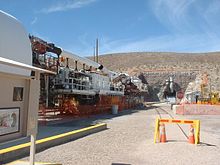
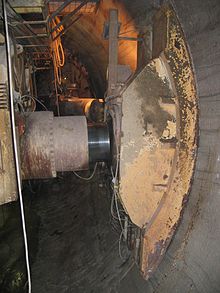
Shielded TBMs erect concrete segments behind the machine to support the tunnel walls. They can bore tunnels through hard rock.
They bore with rotating discs mounted in the cutter head. The disc cutters create compressive stress fractures in the tunnel face. The excavated material (muck) is pushed through openings in the cutter head to a conveyor that carries it through the machine. Once through the machine conveyors/muck cars carry it out of the tunnel.
Double Shield TBMs have two modes; in stable ground they grip the tunnel walls to advance. In unstable, fractured ground, thrust cylinders push against the tunnel segments behind the machine. This keeps the thrust forces from impacting unreinforced tunnel walls.
Single Shield TBMs operate in the same way, but are used only in fractured ground, as they can only push against concrete segments.
Open/Main Beam
Open-type TBMs use their grippers to press against unshielded tunnel walls to maintain pressure on the tunnel face and to advance. They can also be used to bore hard rock. They use similar rotating discs to bore. Machines such as a Wirth machine can be moved only while ungripped. Other machines can move continuously. At the end of a Wirth boring cycle, legs drop to the ground, the grippers are retracted, and the machine advances. The grippers then reengage and the rear legs lift for the next cycle.
Main Beam machines do not install concrete segments behind the cutter head. Instead, the rock is held up using ground support methods such as ring beams, rock bolts, shotcrete, steel straps, ring steel and wire mesh.
Earth Pressure Balance machine

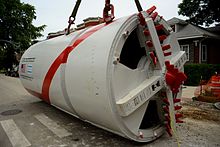
Earth Pressure Balance Machines (EPB) are used in soft ground with less than 7 bar of pressure. They use thrust cylinders to advance by pushing against concrete segments. The cutter head uses a combination of tungsten carbide cutting bits, carbide disc cutters, drag picks and/or hard rock disc cutters. It uses muck to maintain pressure at the tunnel face. The rate of extraction of spoil (using an Archimedes screw) and the advance rate can be adjusted to achieve the desired pressure. Additives such as bentonite, polymers and foam can be injected ahead of the face to stabilize the ground. They can separately be injected in the cutterhead/extraction screw to ensure that the spoil is sufficiently cohesive to maintain pressure and restrict water flow.
Slurry Shield
Slurry Shield machines can be used in soft ground with high water pressure or where ground conditions are granular (sands and gravels) do not allow a plug to form in the screw. The cutter head is filled with pressurised slurry typically made of bentonite clay that applies hydrostatic pressure to the face. The slurry mixes with the muck before it is pumped to a slurry separation plant, usually outside the tunnel.
Slurry separation plants use multi-stage filtration systems that separate spoil from slurry to allow reuse. The degree to which slurry can be 'cleaned' depends on the relative particle sizes of the muck. Slurry TBMs are not suitable for silts and clays as the particle sizes of the spoil are less than that of the bentonite. In this case, water is removed from the slurry leaving a clay cake, which may be polluted.
A caisson system is sometimes placed at the cutting head to allow workers to operate the machine, although air pressure may reach elevated levels in the caisson, requiring workers to be medically cleared as "fit to dive" and able to operate pressure locks.
Open face soft ground
Open face soft ground TBMs rely on the excavated ground to stand without support for a short interval. They are suitable for use in ground with a strength of up to ~10 MPa with low water inflows. They can bore tunnels with cross-section in excess of 10 metres. A backactor arm or cutter head bore to within 150 mm of the edge of the shield. After a boring cycle, the shield is jacked forward to begin a new cycle. Ground support is provided by precast concrete, or occasionally spheroidal graphite iron (SGI) segments that are bolted or supported until a support ring has been added. The final segment, called the key, is wedge-shaped, and expands the ring until it is tight against the ground.
Micro-tunnel shield
Micro tunnel shield TBMs are used to construct small tunnels, and is a smaller equivalent to a general tunnelling shield and generally bore tunnels of 1 to 1.5 m (3.3 to 4.9 ft), too small for operators to walk in.
Backup systems
Behind all types of tunnel boring machines, in the finished part of the tunnel, are trailing support decks known as the backup system, whose mechanisms can include conveyors or other systems for muck removal; slurry pipelines (if applicable); control rooms; electrical, dust-removal and ventilation systems; and mechanisms for transport of pre-cast segments.
Urban tunnelling and near-surface tunnelling
Urban tunnelling has the special requirement that the surface remain undisturbed, and that ground subsidence be avoided. The normal method of doing this in soft ground is to maintain soil pressures during and after construction.
TBMs with positive face control, such as earth pressure balance (EPB) and slurry shield (SS), are used in such situations. Both types (EPB and SS) are capable of reducing the risk of surface subsidence and voids if ground conditions are well documented. When tunnelling in urban environments, other tunnels, existing utility lines and deep foundations must be considered, and the project must accommodate measures to mitigate any detrimental effects to other infrastructure.
